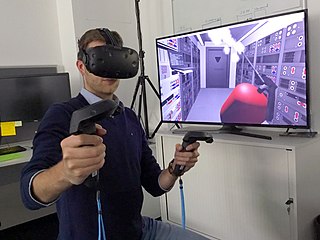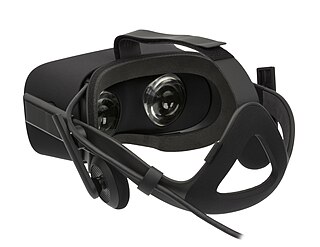Related Research Articles

Virtual reality (VR) is a simulated experience that can be similar to or completely different from the real world. Applications of virtual reality include entertainment and education. Other distinct types of VR-style technology include augmented reality and mixed reality, sometimes referred to as extended reality or XR.

A head-mounted display (HMD) is a display device, worn on the head or as part of a helmet, that has a small display optic in front of one or each eye. An HMD has many uses including gaming, aviation, engineering, and medicine. Virtual reality headsets are HMDs combined with IMUs. There is also an optical head-mounted display (OHMD), which is a wearable display that can reflect projected images and allows a user to see through it.

Oculus Rift is a line of virtual reality headsets developed and manufactured by Oculus VR, a division of Facebook Inc., released on March 28, 2016.

The Virtuix Omni is an omnidirectional treadmill simulator for virtual reality games and other applications. It uses a platform to simulate locomotion i.e. the motion of walking, requiring both special shoes or shoe covers and a surface that reduces friction. It works in conjunction with the HTC Vive, and allows a vive user to walk within a limited number of games.
Eve: Valkyrie is a multiplayer dogfighting shooter game set in the Eve Online universe that is designed to use virtual reality headset technology. Originally launched for Microsoft Windows for use with the Oculus Rift virtual reality headset, CCP Games has announced they plan to enable cross-platform play between the three major VR systems: the Oculus Rift, the HTC Vive, and the PlayStation VR. Released in March 2016, the game has two game mode options: Chronicles can be played in single player, while Combat allows eight by eight combat PvP missions. Reviews generally criticised the limited plot and limitations of single player mode, although the described "arcade experience" was praised for having intuitive controls and "exhilarating" dogfighting features, with PC Powerplay dubbing it "arguably the best VR experience currently available for the [Oculus Rift] platform."

The HTC Vive is a virtual reality headset developed by HTC and Valve. The headset uses "room scale" tracking technology, allowing the user to move in 3D space and use motion-tracked handheld controllers to interact with the environment.

A virtual reality headset is a head-mounted device that provides virtual reality for the wearer. Virtual reality (VR) headsets are widely used with video games but they are also used in other applications, including simulators and trainers. They comprise a stereoscopic head-mounted display, stereo sound, and head motion tracking sensors. Some VR headsets also have eye tracking sensors and gaming controllers.

This is a list of virtual reality headsets, which are head-mounted displays used to present virtual reality environments.

The Lab is a virtual reality (VR) video game developed by Valve and released for Windows on April 5, 2016. It uses VR technology to showcase a series of play experiences accessed through a hub room. The game is set in the Portal universe and offers eight different game types that involve short demo experiences that use different aspects of the VR capabilities. Variety is also offered beyond the experiences themselves by the amount of interactability with objects in the environment that is included.
Virtual Desktop is a computer application that displays the user's computer monitor in a three-dimension virtual space, for use with a virtual reality headset. At the time of its release, CNET and Polygon wrote that the software was essential for virtual reality headset owners.

Job Simulator: The 2050 Archives is a virtual reality simulation video game developed and published by Owlchemy Labs for Microsoft Windows, PlayStation 4, and Oculus Quest in which players participate in comical approximations of real-world jobs.
Tilt Brush is a room-scale 3D-painting virtual-reality application available from Google, originally developed by Skillman & Hackett.
MABMAT (rover) is a robotic imaging system designed to capture photographs and videos of crime scenes and map locations in 360 degrees. This robot's main feature is taking 360-degree photos and videos and converting them to virtual crime scene data which can be used with virtual reality headsets to examine the recorded scene.
Foveated rendering is a rendering technique which uses an eye tracker integrated with a virtual reality headset to reduce the rendering workload by greatly reducing the image quality in the peripheral vision.
In virtual reality (VR), positional tracking detects the precise position of the head-mounted displays, controllers, other objects or body parts within Euclidean space. Because the purpose of VR is to emulate perceptions of reality, it is paramount that positional tracking be both accurate and precise so as not to break the illusion of three-dimensional space. Several methods of tracking the position and orientation of the display and any associated objects or devices have been developed to achieve this. All of said methods utilize sensors which repeatedly record signals from transmitters on or near the tracked object(s), and then send that data to the computer in order to maintain an approximation of their physical locations. By and large, these physical locations are identified and defined using one or more of three coordinate systems: the Cartesian rectilinear system, the spherical polar system, and the cylindrical system. Many interfaces have also been designed to monitor and control one’s movement within and interaction with the virtual 3D space; such interfaces must work closely with positional tracking systems to provide a seamless user experience.

VRChat is a free-to-play massively multiplayer online virtual reality social platform created by Graham Gaylor and Jesse Joudrey. It allows players to interact with others as 3D character models. The game was released for Microsoft Windows as a standalone application compatible with the Oculus DK1 development kit on January 16, 2014, and via Steam's early access program on February 1, 2017. It supports the Oculus Rift, Oculus Rift S, Oculus Quest, and the newly added Oculus Quest 2 via the Oculus Store, the HTC Vive series, Windows Mixed Reality headsets and the Valve Index through SteamVR. Notably, it also supports full-body humanoid avatar tracking via Vive Trackers, though none of these accessories are mandatory to play.

Oculus Rift CV1, also known simply as Oculus Rift, is a virtual reality headset created by Oculus VR, a division of Facebook Inc. It was announced on January 2016, and released in March the same year. The device constituted the first commercial release in the Oculus Rift lineup. In March 2019, the device's production was discontinued, being replaced by the Oculus Rift S. However, Oculus VR has stated that they will continue to support existing devices.

NeosVR is a free-to-play massively multiplayer online virtual reality metaverse created by Solirax. It allows users to interact with one another as avatars and features development tools for players to create games, maps, avatars and more in-game. NeosVR was released for free on Microsoft Windows via Steam on May 4, 2018, and currently supports several different VR headsets.
References
- 1 2 Paul James (5 April 2016). "HTC Vive Review: A Mesmerising VR Experience, if You Have the Space". Road to VR. Retrieved 2016-12-15.
- ↑ "An extra $79 turns the Oculus into a room-scale VR system". Engadget.com. 2016-10-06. Retrieved 2016-12-15.
- ↑ Sean Hollister (2015-06-13). "Oculus Founders Explain Why You'll Likely Stay Seated In Virtual Reality". Gizmodo.com. Retrieved 2016-12-15.